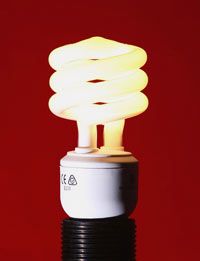If you want to go green but aren't quite ready to build a new home, here are some ways to make your existing home more environmentally friendly (check out the guidelines for new homes at How LEED Certification Works).
Recycled materials
Recycled building materials can be postindustrial (industrial byproducts) or postconsumer (recycled wood, metal, concrete). You can find a recycled version of pretty much any building material.
- Recycled fly-ash from industrial furnaces makes concrete high-strength. Concrete can also be pulverized and remixed with cement to make new concrete.
- If you're building a deck, you can use "wood" made from recycled bottles.
- Steel is easily melted down and re-formed into new structural shapes.
- Sneaker soles can be shredded to make athletic surfaces.
- Even buildings that are imploded into a pile of rubble are recycled. Equipment, like large claws and shears, can crush and separate steel and concrete into separate piles for recycling.
Floors
Bamboo and cork floors are becoming popular choices because of their resemblance to traditional hardwood floors. The main problem with traditional hard woods -- like pine, maple and oak -- is that those forests take decades to regrow. Oak can take up to 120 years to fully mature [source: Treehugger]. But bamboo and cork are fast-growing: Bamboo (which is actually a grass) generally regenerates in about four to six years, and cork plants regrow in about nine years. Both get extra green points because their installation processes don't require toxic adhesives and produce less air-polluting fumes. They're also comparable in price to other wood floors, but there are more than a thousand varieties of bamboo and cork, so quality, color and price can vary widely. The Consumer Reports 2008 Buying Guide reported that bamboo and cork floors are susceptible to UV-ray discoloration, and some types require special cleaning products [source: Consumer Reports].
Other green flooring options include manufactured or engineered wood floors. These are actually veneers, made of layers of wood (often recycled) laminated together. They're typically cheaper and easier to install than traditional hardwood floors, but they also aren't as durable.
Tankless water heaters
Tankless water heaters produce heat only when a hot water tap is turned on, so they don't waste energy in "standby" mode. The water moves directly through the heater as it is needed -- it isn't stored in a tank. Tankless heaters can be electric or gas-powered (gas usually provides a higher water flow) and they come in various sizes. You can get one for the entire house or only for one appliance -- the dishwasher, for example. They are more expensive than conventional water heaters, but considering that heating water accounts for 15 percent of the average home's energy bills, you could recoup that cost sooner than later [source: Alliance to Save Energy].
Insulation
Consumer Reports says that heating and cooling costs comprise 45 percent of the average homeowner's utility bills [source: Consumer Reports]. According to the government's Energy Star site, extra insulation can cut those costs by 15 to 20 percent.
But installation of traditional fiberglass insulation requires a mask and gloves, which brings up a problem: If the fiberglass is so toxic that it can't be inhaled or touched, why are we sealing ourselves into the house with it? Recycled denim and shredded newsprint are quickly becoming the hottest green alternatives for insulation. Traditional fiberglass insulation has been refined over the years, but recycled materials don't contain as many chemicals (and they keep trash out of landfills). Recycled material is pricier, but it typically rates better than traditional fiberglass in insulation tests.
On the next page we'll find out about more possible green additions to your home.




